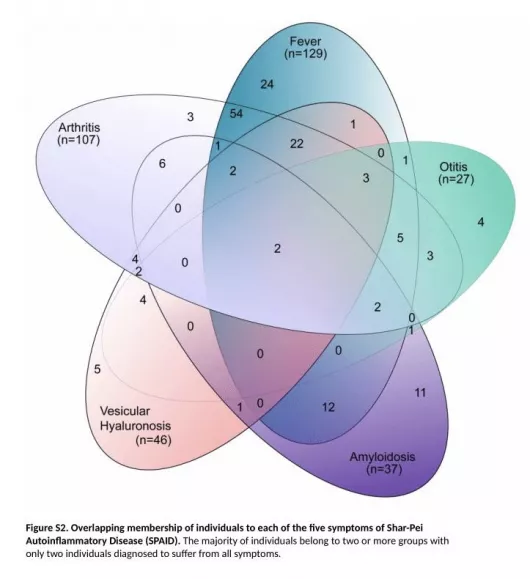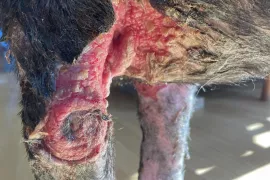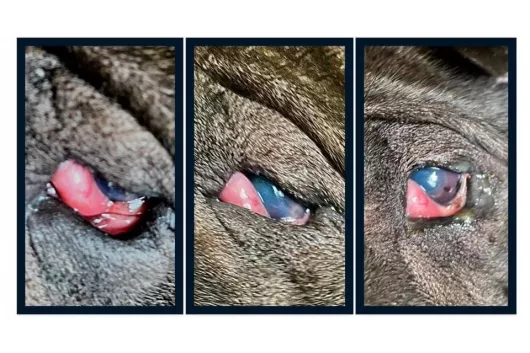Health
What breed specific health issues does the Shar Pei have? What are the underlying genetics? Does appearance make a difference?
This page refers to the entire worldwide Shar Pei population, as all Shar Pei share an underlying genetic characteristic that defines them as Shar-Pei, despite geographically slightly different populations. General statements such as "one population is healthier than the other" are not acceptable, since the data are too scarce to make general statements.
As special as the Shar Pei appears with its wrinkles, the effects of the underlying genetic situation are also much discussed.
Genetic peculiarity of the Shar Pei
Common to all Shar Pei is a mutation of a regulatory gene of HAS2 (hyaluronic acid synthetase 2) on chromosome 13. This mutation is present as a so-called CNV (Copy Number Variation), which means that the number of mutations in the individual varies. In all Shar Pei, we can find it at least twice, but may also be present in higher numbers. The more copies that are present, the higher the activity of HAS2 and the more hyaluronic acid is formed and incorporated as a basic substance into the tissue. The skin becomes fainter, thicker, contains more water and produces more wrinkles and a thick muzzle.1 A HAS2 gene test is available.
Another mutation that is more common in SharPei is a missense mutation in the MTBP gene, also on chromosome 13. This mutation causes a protein that plays a role in inflammatory metabolism to have a "malfunction". The affected dogs often develop a disease with increased inflammatory activity (SPAID = Shar Pei Autoinflammatory Disease).2 A MTBP gene test is available.
Furthermore, Shar peis more often than other breeds suffer from a relevant vitamin B12 deficiency. Here, too, a genetic change is probable as the cause, also in a region on chromosome 13.3
Some other genetic changes are suspected to be the cause of several more common health disorders.
Consequences of these genetic mutations
Shar Pei AutoInflammatory Disease (SPAID)
SPAID, is probably the most mentioned and feared health disorder of the Shar Pei. This is an auto-inflammatory disease that occurs in approximately 23% of Shar-Pei.7 Dogs affected by SPAID suffer from episodes of increased inflammatory activity. This inflammatory activity is reflected in high fever episodes ("Shar Pei Fever"), ear infections, joint inflammation, formation of mucin vesicles (mucinosis) and/or amyloidosis.
However, not every Shar Pei affected by SPAID always shows all the symptoms and is often not perceived as ill from the outside. Some Shar Pei who died at a young age from kidney failure due to amyloidosis showed no other SPAID symptoms.
Primary SPAID diseases
Bouts of fever ("Shar Pei fever")
Bouts of high fever ("Shar Pei fever") can develop very suddenly, within less than an hour, and last from a few hours to days (12-36 hours). A Shar Pei with a fever attack is usually clearly ill and often not even able to get up. This inflammatory process can also lead to swelling of joints (often the ankle) and the muzzle. Abdominal pain, pain when breathing and mild nausea and diarrhea can also occur.
The first episodes of fever usually occur before the age of 18 months, but in individual cases can also be observed in old dogs for the first time. The frequency and intensity of fever attacks varies greatly. While some dogs remain relatively inconspicuous with only a single episode in life or even very short fleeting fever episodes of only a few hours, others can suffer from these episodes with a strong feeling of illness very frequently.
Amyloidosis
The symptoms of inflammation are associated with deposits of protein fragments (amyloid type AA) in the extracellular space (between the cells), the so-called amyloidosis. The storage of amyloid in the internal organs leads to organ dysfunction and even organ failure. The kidneys are particularly affected, and more rarely the liver. Many diseased Shar Pei die relatively young in part as a result of kidney failure, more rarely liver failure.9
Otitis (Ear infections)
The increased production of hyaluronic acid promotes greater colonization with yeast fungi and often leads to ear infections. The Shar-Pei's often very narrow ear canals are another beneficial factor.
Mucinosis
The increased production and storage of hyaluronic acid can also encourage blistering on the skin. These small, visible sacs filled with mucin ("mucin vesicles") can develop particularly on the chest and legs. They are filled with a water-white, stringy liquid called mucin. Occasionally, these blisters can cause itching or rupture, and scratching/dirtying can also cause secondary inflammation.
Joint inflammation
The auto-inflammatory processes can lead to periodic swelling around a joint, with or without inflammation of the joint itself. In most cases, the ankle is affected ("swollen hock syndrome"). Sometimes a painfully swollen muzzle is observed at the same time. Diagnostically, a distinction must be made between a "swollen hock syndrome" caused by inflammatory processes and permanent, overhanging skin folds on the joints, that some severely wrinkled Shar Pei have.10
Secondary SPAID diseases
Inflammation of the skin
The wrinkling caused by increased hyaluronic acid production in Shar Pei favors a stronger colonization with yeast fungi and can lead to skin inflammation.
Acute febrile neutrophilic vasculitis
Various bacteria, yeasts but also some insects secrete certain enzymes that break down the hyaluronic acid lining the blood vessel walls. This leads to inflammation, which first manifests itself as fever and pain, followed by sometimes very extensive skin lesions. This can cause serious, dramatic and sometimes life-threatening problems in the Shar Pei through the subsequent development of necrosis and ulcers. Acute febrile neutrophilic vasculitis can occur in Shar Pei shortly or immediately after an episode of Shar Pei fever.11
Tumor diseases
Widespread with Shar Pei is the tendency to mast cell-mediated diseases (lipoma, fat growths) and very aggressive mast cell tumors. Changes in mast cell metabolism favor inflammatory reactions in the skin, allergies and the occurrence of mast cell tumors. Mast cells are commonly found in areas affected by mucinosis in affected Shar Pei.12
Other diseases related to the genetic situation
Brachiocephalic obstructive airway syndrome (BOAS)
Although the Shar Pei is not a brachiocephalic breed, some Shar Pei suffer from a similar set of symptoms caused by narrowing of the airways from thickened mucous membranes. The cause here is again the increased storage of hyaluronic acid, which leads to swelling of the tissue. In the affected dogs, this leads to reduced performance, poor heat tolerance and an increased risk of anesthesia, as in brachycephalic syndrome. In individual cases, an operative correction in the area of the upper respiratory tract may be necessary.12
Entropion
Pronounced wrinkling of the face can cause the eyelids to curl inward (entropion). Scratching the eyelashes can damage the cornea of the eye. Due to the chronic stimulus, the damage can extend to deep inflammation and resulting blindness. According to OFA, 39.4% of all Shar Pei will be affected by entropion in their lifetime, ranking ahead of the Neapolitan Mastiff of all breeds.
Hypothyroidism
Many Shar Peis suffer from hypothyroidism. It is worth mentioning that in most cases it is an otherwise rare special form of hypothyroidism, tertiary hypothyroidism. The hypothyroidism is caused by an indirect inhibition of TSH release due to the increased hyaluronic acid production. As a result, the thyroid gland, which is healthy in itself, does not get a working signal and produces too few hormones. In this case, even if the TSH value in the laboratory test is normal or low, with clinical symptoms and a low T4 value, substitution with thyroid hormones is necessary. Symptoms can include: skin and fur changes (thin, soft, bleached fur), tiredness, lethargy, irritability, intolerance, weight gain, leg and face edema, frequent ear infections.
Other diseases that occur frequently in Shar Pei
Skin diseases
The Shar Pei is more sensitive to Demodex mite infestation, seborrheic or atopic dermatitis.
Primary open-angle glaucoma and lens luxation (POAG/PLL)
One eye disease that occurs in the Shar Pei is primary open-angle glaucoma and lens luxation (POAG/PLL). Primary open-angle glaucoma (POAG) is a connective tissue disorder in the eye that is often genetically conditioned. This means that the aqueous humor cannot drain properly. The resulting increase in internal pressure in the eye puts a strain on the optic nerve and the retina, is very painful for the dog and can ultimately lead to blindness. Symptoms include dilated pupils, red eyes, cloudy cornea, and increased intraocular pressure. A sharp increase in pressure causes great pain, which can lead to a loss of appetite, scratching of the eyes, rubbing of the head on objects and aggressiveness. The connective tissue disorder often also causes a luxation of the lens in the eye (PLL). Most affected dogs become ill around the age of 4-6 years.8 A POAG/PLL gene test is available.
Prolapse of the nictitating gland (Cherry Eye)
An exact reason for the protrusion of the lacrimal gland behind the nictitating membrane is not known. Breeds with known connective tissue disorders are often affected. If left untreated, scratching by the dog can lead to infections and injuries to the nictitating gland, and the cornea can also be damaged as a result.
Hiatal hernia (diaphragmatic hernia)
A diaphragmatic hernia occurs when the upper part of the stomach passes through the diaphragm from the abdomen into the chest. The Shar Pei is one of the disproportionately affected breeds. The exact cause is still unclear, an as yet unknown genetic defect is suspected. In the case of smaller hernias, affected dogs are often symptom-free. Symptoms that are often observed during physical exertion or states of excitement are vomiting, belching, excessive salivation, blood in the vomit and difficulty breathing.13
Hypocobalaminemia (Vitamin B12 deficiency)
Vitamin B12 deficiency is often found (50-80%) in Shar-Pei. The exact cause of the B12 deficiency in this breed is still unclear. There is an association with certain microsatellites that suggests it may be an alteration on chromosome 13. The common effects would be haematopoietic disorders and neurological disorders. Undetected and untreated, long-term behavioral changes, especially anxiety and nervousness, can occur.3
Immunoglobulin A deficiency
Shar Peis, among others, often have a reduced IgA level in their blood. This change in the immune system makes the affected dogs more susceptible to respiratory infections and allergies.4
Source index
(1) A novel unstable duplication upstream of HAS2 predisposes to a breed-defining skin phenotype and a periodic fever syndrome in Chinese Shar Pei dogs.
(Olsson et al. PloS Genetics Mar 2011)
(2) Whole genome sequency identifies missense mutation in MTBP in Chinese Shar Pei affected witch autoinflammatory disease (SPAID)
(Metzger J. et al. BMC Genomics 2017)
(3) Association study of Cobalamine deficiency in the Chinese Shar Pei
(Grützner et al. 11/2009 The Journal of Heredity 101)
(4) Genome-wide analysis suggest mechanisms involving early B-Cell development in canine IgA deficiency
(Olsson et al. PloS One. 2015)
(5) Acute febrile neuropath vasculitis of the skin of young Shar Pei dogs
(Malik R. et al. Aust. Vet. J. 2002)
(6) Epidemiological assessment on the risk of canine mast cell tumorbased on the Kiupel two-grade-malignancy classification
(Smiech et al. Acta Vet Scand 2018)
(7) A canine febrile disorder associated with elevated inteleukin-6
(Riva AL et al. Clin Immunol Immunopathol 1992)
(8) Evaluation of ADAMTS17 in Chinese Shar-Pei with primary open-angle glaucoma, primary lens luxation, or both
Am J Vet Res. 2018 Jan;79(1):98-106.doi: 10.2460/ajvr.79.1.98.
(9) Thorough investigation of a canine autoinflammatory disease (AID) confirms one main risk locus and suggests a modifier locus for amyloidosis
PLoS One. 2013 Oct 9;8(10):e75242. doi: 10.1371/journal.pone.0075242. eCollection 2013.
(10) http://wvc.vetstreet.com/familial-shar-pei-fever Dr. Linda Tintle, DMV
(11) https://www.drlindatintle.com/wp-content/uploads/SP-HA-SPAID-ch-LTintle-May-19_2016.pdf Dr. Linda Tintle, DMV
(12) https://cspca.com/wp-content/uploads/2020/02/ownersguidebooklet.pdf Dr. Linda Tintle, DMV, Dr Jeff Vidt, DMV





